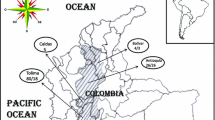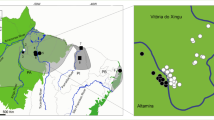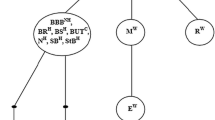Abstract
Mitochondrial DNA, purified from 36 samples of 23 local populations which are widely distributed in Vietnam, Burma, and 10 provinces of China, has been analyzed to model the phylogeny of rhesus monkeys. The 20 local populations of China may represent nearly all major populations in China. Using 20 restriction endonucleases of 6-bp recognition, we observed a total of 50–61 sites in the various samples. By combining the cleavage patterns for each enzyme, the 36 samples were classified into 23 restriction types, each of which was found exclusively in the respective population from which samples were obtained. By combining the earlier study of Indian rheusus monkeys, phylogenetic trees, which have been constructed on the basis of genetic distance, indicate that rhesus monkeys in China, Vietnam, India, and Burma can be divided into seven groups. Integrating morphological and geographical data, we suggest that rhesus monkeys in China, Vietnam, and Burma may be classified into six subspecies—M. m. mulatta, M. m. brevicaudus, M. m. lasiotis, M. m. littoralis, M. m. vestita, and M. m. tcheliensis-and rhesus monkeys in India may be another valid subspecies.M. m. tcheliensis is the most endangered subspecies in China. Divergence among subspecies may have begun 0.9–1.6 Ma. The radiation of rhesus monkeys in China may have spread from the southwest toward the east. The taxonomic status of the Hainan monkey and the Taiwan monkey require further investigation.
Similar content being viewed by others
References
Allen, G. M. (1938).The Mammals of China and Mongolia, Part I, American Museum of Natural History, New York.
Annenkov, H. A., Mirvis, A. B., and Kotrikadze, H. G. (1972). Geographical transferring polymorphism inMacaca mulatta.Primates 13: 235–242.
Avise, J. C., Arnold, J., Ball, R. M., Bermingham, E., Lamb, T., Neigel, J. E., Reeb, C. A., and Saunders, N. C. (1987). Intraspecific phylogeography: The mitochondrial DNA bridge between population genetics and systematics.Annu. Rev. Ecol. Syst. 18: 489–522.
Brown, W. M. (1980). Polymorphism in mitochondrial DNA of humans as revealed by restriction endonuclease analysis.Proc. Natl. Acad. Sci. USA 77: 3605–3609.
Brown, W. M. (1983). Evolution of animal mitochondrial DNA. In Nei, M., and Koehn, R. K. (eds.),Evolution of Genes and Proteins. Sinauer, Sunderland, MA, pp. 62–88.
Brown, W. M., George, M., Jr., and Wilson, A. C. (1979). Rapid evolution of animal mitochondrial DNA.Proc. Natl. Acad. Sci. USA 76: 1967–1971.
Delson, E. (1980). Fossil Macaques, phyletic relationships and a scenario development. In Lindburg, D. G. (ed.),The Macaques: Studies in Ecology, Behaviour and Evolution, Van Nostrand Reinhold, New York, pp. 10–30.
Easteal, S. (1991). The relative rate of DNA evolution in primates.Mol. Biol. Evol.8: 115–127.
Ellerman, J. T., and Morrison-Scott, T. C. S. (1951).Checklist of Palaearctic and Indian Mammals, 1758–1945. British Museum of Natural History, London.
Elliott, D. G. (1912).A Review of the Primates, Vol. 2. American Museum of Natural History. New York.
Fa, J. (1989). The genusMacaca: A review of taxonomy and evolution.Mammal Rev. 19: 45–81.
Ferris, S. D., Sage, R. D., Prager, E. M., Ritte, U., and Wilson, A. C. (1983). Mitochondrial DNA evolution in mice.Genetics 105: 681–721.
Fooden, J. (1980). Classification and distribution of living macaques (Macaca Lecepede). In Lindburg, D. G. (ed.),The Macaques: Studies in Ecology, Behaviour and Evolution, Van Nostrand Reinhold, New York, pp. 10–30.
Fooden, J., Mahabal, A., and Saha, S. S. (1981). Redefinition of rheusus macaque—bonnet macaque boundary in Peninsular India (Primates:Macaca mulatta, M. radiata).J. Bomb. Nat. Hist. Soc. 788: 463–474.
Gu, Y. M. (1980). A Pliocene macaque's tooth from Zhongxiang, Hubei.Vertebr. Palasiat. 18: 324–326.
Harihara, S., Saitou, N., Hirai, M., Aoto, N., Terao, K., Cho, F., Honjo, S., and Omoto, K. (1988). Differentiation of mitochondrial DNA types inMacaca fascicularis.Primates 29: 117–127.
Harrison, R. G. (1989). Animal mitochondrial DNA as a genetic marker in population and evolutionary biology.Trends Ecol. Evol. 4: 6–11.
Hayasaka, K., Horai, S., Gojobori, T., Shotake, T., Nozawa, K., and Matsunaga, E. (1986). Mitochondrial DNA polymorphism in Japanese monkeys,Macaca fuscata.Jpn. J. Genet. 61: 345–359.
Hayasaka, K., Horai, S., Gojobori, T., Shotake, T., Nozawa, K., and Matsunaga, E. (1988). Phylogenetic relationships among Japanese, rhesus, Formosan, and crab-eating monkeys, inferred from restriction enzyme analysis of mitochondrial DNAs.Mol. Biol. Evol. 5: 270–281.
Hill, W. C. O. (1974).Primates: Comparative Anatomy and Taxonomy, Vol. VII. Cynopithecinae (Cercocebus, Macaca, Cynopithecus), Edinburgh University Press, Edinburgh.
Huang, J. S. (1984). Changes of sea-level since the Late Pleistocene in China. In Whyte, P. (ed.),The Evolution of the East Asian Environment, Vol. 1, Centre of Asian Studies, Hong Kong.
Jablonski, N. G., and Pan, Y. R. (1988). The evolution and palaeobiogeography of monkeys in China. In Whyte, P. (ed.),The Palaeoenvironment of East Asia from the Mid-Tertiary, Vol. II. Oceanography, Palaeozoology and Palaeoanthropology, University of Hong Kong, Hong Kong.
Jiang, X. L., Wang, Y. X., and Ma, S. L. (1991). Taxonomic revision and distribution of subspecies of rhesus monkey (Macaca mulatta) in China.Zool. Res. 12: 241–247.
Lansman, R. A., Shade, R. O., Shapira, J. F., and Avise, J. C. (1981). The use of restriction endonucleases to measure mitochondrial DNA sequence relatedness in natural populations. III. Techniques and potential applications.J. Mol. Evol. 17: 214–226.
Liu, D. S., and Ding, M. L. (1984). The characteristics and evolution of the palaeoenvironment of China since the Late Tertiary. In Whyte, P. (ed.),The Evolution of the East Asian Environment, Vol. I, Centre of Asian Studies, Hong Kong.
Melnick, D. J., and Kidd, K. K. (1985). Genetic and evolutionary relationships among Asian macques.Int. J. Primatol. 6: 123–160.
Napier, J. R., and Napier, P. H. (1967).Handbook of Living Primates, Academic Press, London.
Nei, M., and Li, W. H. (1979). Mathematical model for studying genetic variation in terms of restriction endonucleases.Proc. Nat. Acad. Sci. USA 76: 5269–5273.
Nozawa, K., Shotake, T., Ohkura, Y. and Tanabe, Y. (1977). Genetic variations within and between species of Asian macaques.Jpn. J. Genet. 52: 13–30.
Pan, Y. R., and Jablonski, N. G. (1987). The age and geographical distribution of fossil cercopithecids in China.Hum. Evol. 2: 59–69.
Pocock, R. I. (1939).Mammalia. I. Primates and Carnivora in the Fauna of British India, Including Ceylon and Burma, Taylor and Francis, London.
Qu, G. Q. (1979). Pliocene mammals in Lufeng, Yunnan Province.Vertebr. Palasiat. 17: 14–22.
Quan, G. Q., Wang, S., and Zhang, R. Z. (1981). The taxonomy and distribution of primates in China.Wild Anim. 3: 7–14.
Saitou, N., and Nei, M. (1987). The neighbour-joining method: A new method for reconstructing phylogenetic trees.Mol. Biol. Evol. 4: 406–425.
Sneath, P. H. A., and Sokal, R. R. (1973).Numerical Taxonomy: The Principles and Practice of Numerical Classification, W. H. Freeman, San Francisco.
Spuhler, J. N. (1988). Evolution of mitochondrial DNA in monkeys, apes, and humans.Yearbook Phys. Anthropol. 31: 15–48.
Wen, H. Z., He, Y., and Shiu, Z. (1981). Rhesus monkeys in historical period of North China.Henan Normal Univ. 1: 37–44.
Wilson, A. C., Cann, R. L., Carr, S. M., George, M., Jr., Gyllensten, U. B., Helm-Bychowski, K. M., Higuchi, R. G., Palumbi, S. R., Prager, E. M., Sage, R. D., and Stoneking, M. (1985). Mitochondrial DNA and two perspectives on evolutionary genetics.Biol. Linn. Soc. 26: 375–400.
Wolfheim, J. H. (1983).Primates of the World, University of Washington Press, Seattle.
Zhang, Y. P., and Shi, L. M. (1989). Mitochondrial DNA polymorphism in five species ofMacaca.Chine. J. Genet. 16: 325–338.
Zhang, Y. P., and Shi, L. M. (1991). Genetic diversity in the Chinese pangolin (Manis pentadactyla): Inferred from restriction enzyme analysis of mitochondrial DNAs.Biochem. Genet. 29: 501–508.
Zhang, Y. P., and Shi, L. M. (1992). Phylogenetic relationships of macaques: inferred from restriction enzyme analysis of mitochondrial DNA.Folia Primatol. (in press).
Zhang, Y. P., Chen, Z. P., and Shi, L. M. (1993). Phylogeny of the slow lorises (GenusNycticebus): An approach using mitochondrial DNA restriction enzyme analysis.Int. J. Primatol. 14: 167–175.
Author information
Authors and Affiliations
Rights and permissions
About this article
Cite this article
Zhang, Yp., Shi, Lm. Phylogeny of rheusus monkeys (Macaca mulatta) as revealed by mitochondrial DNA restriction enzyme analysis. International Journal of Primatology 14, 587–605 (1993). https://doi.org/10.1007/BF02215449
Received:
Accepted:
Issue Date:
DOI: https://doi.org/10.1007/BF02215449




